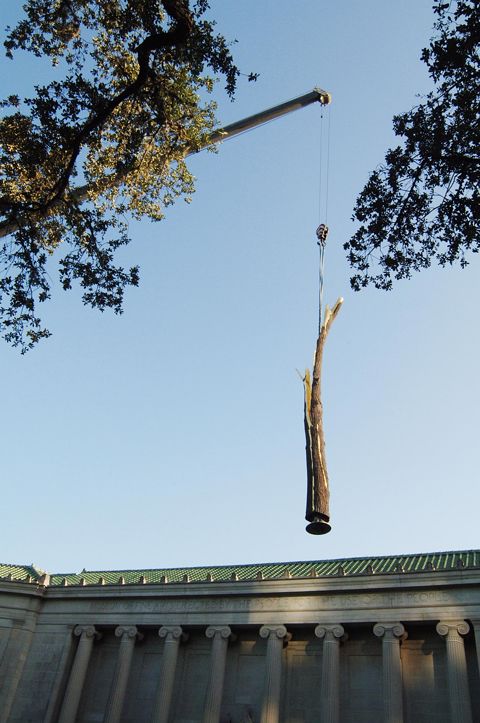Monumental Bronze by Giuseppe Penone Installed at the MFAH; Recent Acquisition Anchors the Museum’s South Lawn

Albero folgorato (Lightning Tree) is hoisted over the roof of the Museum’s Caroline Wiess Law Building. Giuseppe Penone, Albero folgorato (Lightning Tree), 2012, cast and gilded bronze, the Museum of Fine Arts, Houston, Museum purchase funded by the Caroline Wiess Law Accessions Endowment Fund.
HOUSTON—August 25, 2014—The Museum of Fine Arts, Houston, announces the acquisition of Albero folgorato (Lightning Tree) (2012) by renowned Italian artist Giuseppe Penone. Standing over 36 feet tall and cast from an oak tree that had been struck by lightning, Houston’s Albero folgorato is the third and final version of this monumental bronze sculpture, which had its internationally acclaimed debut at the Palace of Versailles in the summer of 2013.
The installation—which involved a flatbed truck, two construction cranes, a 183-foot boom, and a team of art handlers, riggers, and curators—took place on Saturday, August 23. The massive sculpture was delivered on a flatbed truck, then hoisted up from the street, over a grove of Live Oak trees and above the roof of the Museum’s Caroline Wiess Law Building, and lowered in front of its south facade and onto a steel support on a concrete base as onlookers gathered.
“Albero folgorato affirms the Museum’s commitment to public art that is accessible to all of our visitors,” said Gary Tinterow, Museum Director. “Works on the South Lawn and in the Lillie and Hugh Roy Cullen Sculpture Garden serve to enhance our campus while bringing art outdoors for all.”
“Giuseppe Penone has a magical touch with sculpture, which always seems to come alive in his hands,” said Alison de Lima Greene, Curator of Contemporary Art and Special Projects. “Although Albero folgorato weighs more than two tons, it seems to defy gravity as it reaches to the sky, while the naturalistic form of the tree is animated by its gilded interior. Struck by lightning, Albero folgorato captures a moment in time and yet stands fixed as a timeless monument.”
About Giuseppe Penone
Giuseppe Penone was born in 1947 in Garessio, a rural community south of Turin, Italy. By 1968, he had become identified with the Arte Povera movement, Italy’s foremost contribution to the postwar avant-garde, and by the early 1970s he had gained wide recognition both in Europe and the United States. Penone is the recipient of many awards, including the 2014 Praemium Imperiale, and in 2007 he represented Italy at the Venice Biennale.
In addition to the Museum of Fine Arts, Houston, Penone’s work is featured in collections worldwide, including the Centre Pompidou, Paris; the Museum of Modern Art, New York; and the Tate Modern, London. Penone’s monumental bronze trees, including Albero folgorato, have been the subject of special exhibitions at Versailles (2013) and at Forte Belvedere and Boboli Gardens, Florence (2014).
Additional Recent Acquisitions on View
The Museum of Fine Arts, Houston, is currently highlighting other recent acquisitions, along with Modern and Contemporary works from the collection, in two special installations in Upper Brown Pavilion of the Museum’s Caroline Wiess Law Building.
Europe 1900–1975: Selections from the Museum’s Collection features outstanding artwork spanning the Modern era, including a rare Red/Blue Chair (c. 1920), designed and made by Gerrit Rietveld. For this iconic piece, Rietveld transformed the concept of the great armchair into a more reductive, geometric composition whose color palette takes its cues from the De Stijl movement. The Museum’s example is one of only 15 from the period, and the chair retains a significant amount of its original surface.
Contemporary Art: Selections from the Museum’s Collection showcases recent acquisitions that represent the Museum’s wide-ranging engagement with contemporary art across world cultures and disciplines, including Julie Mehretu’s Mogamma, A Painting in Four Parts: Part 4 (2012), a monumental canvas that addresses the aspirations and chaos of the Arab Spring; Soundsuits (2011), two paired figures by Nick Cave; Monir Shahroudy Farmanfarmaian’s brilliantly reflective Nonagon (2011), which unites Minimalist aesthetics with mirror mosaic techniques from Islamic architecture; Andrea Branzi’s Prototype for Tree 5 (2008–10), in which nature and structure coexist in a delicate balance; the haunting and mournful A negra (The Black Woman) (1997) by Carmela Gross; Norberto Nicola’s Queda II (1987), a richly woven wall relief that unites the geometric principles of his paintings with textures drawn from Pre-Columbian artistic traditions; and Mysteries (1987), a text-based painting by Ed Ruscha, which has come to the Museum as a gift from the estate of longtime patron and philanthropist Isabel B. Wilson.
Media Contacts
Mary Haus, head of marketing and communications
Laine Lieberman, publicist
Sara Blair Matthews, marketing and communications coordinator
smatthews@mfah.org / 713.639.7554
Mary Haus, head of marketing and communications
Laine Lieberman, publicist
Sara Blair Matthews, marketing and communications coordinator
smatthews@mfah.org / 713.639.7554
